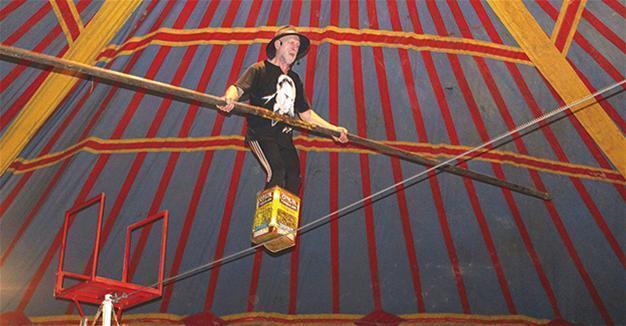Balıkesir man walking on wire for over half a century
BALIKESİR – Anadolu Agency

AA photo
Özdemir Turan seems like the last of a dying breed, but if he has his way, he won’t. After more than five decades engaged in the wire-walking business – a traditional Turkish art that dates back millennia – the 67-year-old says he’s as keen as ever to pass along his craft to someone from the younger generation.“I once had an apprentice but he could not become a professional yet. This is why I don’t want to die until I train an apprentice to a professional,” he said.
Turan, who is a dentist and who recently arrived in the northwestern province of Balıkesir’s Ayvalık district for the Eurasia Circus, said all the big Turkish masters of wire-walking had died.
“I wish the world had known the Turkish masters of this profession when they were still alive. I am only their apprentice, but I’m happy that at least I had chance to work with five or six of them,” he said.
“There have been hundreds, maybe thousands of wire-walkers over time in Turkey. They are particularly mentioned in Evliya Çelebi’s ‘Seyahatname’ [Book of Travels],” Turan added, referring to the legendary 17th-century Ottoman traveler.
Turan’s first master was Selim Öktülmüş, nicknamed Farabi, from the Greek city of Thessaloniki.
“I was his apprentice for years. We went to Ortaca in Dalaman in Muğla. There I watched shows by the famous Yakup, known as ‘Wire-walker Yakubi.’ I was impressed by him. All of them were great masters,” he said.
“I have completed 51 years in this profession so far, including my years of apprenticeship. But I will not stop. I want to be involved with the profession until the end of my life. This art has been included in the UNESCO World Heritage list and I am the only professional representative of this profession in Turkey,” Turan added.
‘We had this art before the world knew it’
Turan said wire-walking was an old Turkish tradition. “Circuses and circus academies did not exist in the world, but we had this art. Today, there are lots of circus academies in the world, established by the states, and artists are trained in these academies. But unfortunately, we have not received this support in our country. So far, I have talked to six culture and tourism ministers, telling them that I am the only representative of this profession. But I have not received any support.”
The founder and art director of the Eurasia Circus, Servet Yalçın, said their goal was to protect the 4,000-year-old cultural heritage of Turks and inculcate a love for the art among younger generations.
Yalçın said Turan was at the peak of the wire-walking profession and that he attached great importance to teaching young generations.
“This is why Turkey needs a circus academy. Relevant institutions should do something about it. The circus did not exist in any other part of the world in the 17th century, but our artists from the capital of the Ottoman Empire, Istanbul, carried this art to the world. In those days, more than 3,000 wire-walkers and acrobats were traveling around the world. But today there are no more than a few people doing this.”
Yalçın called for officials to modernize the traditional Turkish arts and establish new and bigger circus academies.
















